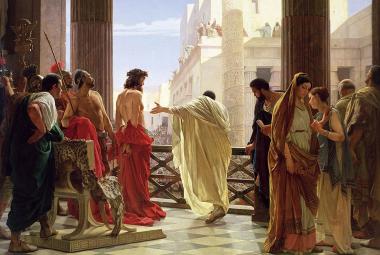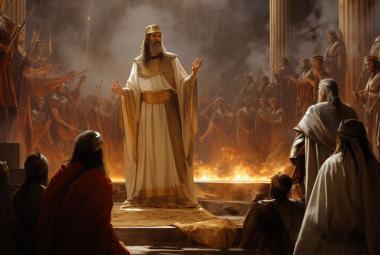In Israel the winter rains were late this year (April 1994) so the land was lush and green with wild flowers abounding. Along the roadsides, there were continual clumps of small bushes with bright yellow flowers that, like almost everything else in Israel, carried some Biblical insights for us.
Ruthie Geva, our guide, pointed out to us that these ubiquitous plants are the famed "mustard" plants frequently alluded to in the Bible. The remarkable thing about them is that they grow as bushes,about 3 or 4 feet high. This surprised many of the inquisitive pilgrims on our tour since we all remember the parable in Matthew 13 where this bush grew into a tree that provided a refuge for the birds in its branches. (Birds are rarely attracted to a bush only 4 feet high!)
The Mysteries in Matthew 13
This is but one example of the possibility of misunderstanding the application of the "Kingdom Parables" of Matthew 13. In this chapter, Jesus presented His disciples seven prophetic illustrations that deserve very careful study.
Why Parables?
In verses 10 - 17, Jesus highlights the reason He spoke in parables. They were not intended to reveal, but to conceal! (Check it out.)
The first two parables offer little difficulty, since Jesus, when they were alone in private, explained them. (Verses 18-23 and 36-43.) It is interesting to notice that the idioms used in the parables are used consistently. Theologians refer to this as the Principle of Expositional Constancy. (Isn't interesting how you can give impressive labels to simple insights?)
It is the other five parables, then, that give us the problems. In fact, the more you study them, the more questions they raise!
The Woman and the Leaven
In verse 33, there is a brief, one verse, puzzle:
The Kingdom of Heaven is like leaven, which a woman took, and hid in three measures of meal, till the whole was leavened.
It has been popular to view this as a prediction that the Church will eventually "convert" the entire world. Unfortunately, this would seem to contradict other prophecies.1 (Luke 18:8; Isaiah 63:3,5; 2 Peter 2; Jude, etc.)
Furthermore, we must never lose sight of the fact that Jesus was a Jewish rabbi, speaking to Jewish disciples.Leaven is always used as a symbol of sin. The Feast of Passover emphasizes the use of unleavened bread. Even to this day, the Jews make a game out of cleansing the house of leaven: they hide a little for the children to find to earn a reward. Jesus refers to the "leaven of Pharaisees and Sadducees."2 (Matthew 16:6; Luke 13:21.) Paul also makes these same type of references.3 (1 Corinthians 5:6-8; Galations 5:7-9.)
It is interesting that the Feast of Israel that prophesizes the Church is the Feast of Pentecost, the only feast that features leavened (Gentile?) bread.4 (See our Briefing Package, The Feasts of Israel, a prophetic study of all of the Feasts.)
Why is leaven used as a symbol of sin? It corrupts by puffing up. The origin of sin was in Lucifer's pride.5 (Isaiah 14:12-17.) That's why God hates pride. (Try that in your concordance sometime!)
Furthermore, the "three measures of meal" have their origin in Genesis 18, where Abraham receives the famous three visitors. This first was the Lord Himself, and the other two were angels who had an assignment the following day at Sodom and Gomorrah.
From that day to this, in both the Jewish and Arab cultures, the "three measures of meal" are emblematic of a fellowship offering.
So to a Jewish ears, when Jesus described a woman putting leaven into the three measures of meal, they probably gasped in horror! What can this mean?
The Pearl of Great Price
In verses 45-46, Jesus again uses a strange Gentile allusion: the pearl. It all sounds good, until you realize that oysters are not kosher!6 (Deuteronomy 14:10.)
Here again, we see an allusion to the Church. The pearl is the only "jewel" that is the result of a living organism. It grows as a response to irritation. And it is removed from its place of growth to become an item of adornment!
The more we study these parables, the more questions they raise.
The Church is the Focus
In fact, in verses 34-35, Jesus announces that the revelations in these parables are not to be found in the Old Testament! Paul, in Ephesians 3:4-7 indicates that this very mystery is the Church itself,7 not revealed in the Old Testament. This uniqueness is also alluded to in verse 52.
The Mustard "Tree"
The puzzling character of these parables is no more evident than in the Mustard "Tree." Despite the well-meaning Bible dictionaries that attempt to link this parable to various flora of the Middle East, the common mustard plant grows as a small bush, and is hardly the haven for birds.
Furthermore, the identity of the birds have already been revealed in verse 19 (cf. v.3): the ministers of the "Wicked One!" This seems to portray a view in which the church will grow into something never intended--a monstrosity in which the very ministers of the wicked one will find refuge in its branches! (Doesn't that sound descriptive of some of the activities of the present day? Should we be surprised?)
The Seven Epistles of Christ
In verses 9 and 43, we can't miss the familiar phrase, "He that hath ears to hear, let him hear." It is interesting that Jesus demarked His "Seven Letters to Seven Churches"8 (in Revelation Chapters 2 and 3) with this very phrase.
(These two chapters of the Book of Revelation are the most important--and the most practical--of the entire Book.)
As we study carefully, these seven letters, dictated by Jesus Himself, we notice that they bear evidence of very precise structure and design. We notice that the fourth letter features a woman who introduces false doctrine. Could this correspond to the fourth parable, the woman introducing the leaven?
We notice that the sixth letter speaks of the removal of the church. Could this corresponce to the sixth parable, the pearl which must removed from its place of growth to become the object of adornment?
In fact, it would seem that the seven Letters to Seven Churches parallel the seven "Kingdom Parables" of Matthew 13 rather closely. Is this a coincidence?
(The rabbis tell me that "coincidence" is not a kosher word.) But there may be more.
The Seven Churches of Paul
The Apostle Paul signed 13 epistles in the New Testament. But three of these are "doubles:"Corinthians, Timothy, and Thessalonians. That leaves 10 addressees. But three of these are "pastors," not churches. That leaves seven churches that Paul addressed. Is there a mystical significance to this? Is there an intrinsic, designed, relationship between the seven churches that Paul addressed and the seven churches of Revelation 2 and 3?
Here I'll pass the ball to you. If you take the time to really study them, you are in for a pleasant surprise. The fingerprints of the Holy Spirit are all over them. Good hunting!
(If you want a running start on this one, you might want to review our Briefing Package, The Letters to Seven Churches.)
Notes:
- Luke 18:8; Isaiah 63:3,5; 2 Peter 2; Jude, etc.
- Matthew 16:6; Luke 13:21.
- 1 Corinthians 5:5-8; Galations 5:7-9.
- See our Briefing Package, The Feasts of Israel, a prophetic study of all the Feasts.
- Isaiah 14:12-17.
- Deuteronomy 14:10.
- Ephesians 3:4-7.
- Revelation 2 & 3. These two chapters of the Book of Revelation are the most important--and the most practical--of the entire Book.






